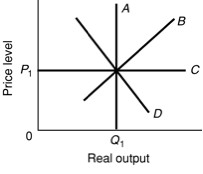 |
| 1 |  | 
Comparing the short-run and long-run Phillips curve suggests that: |
|  | A) | there is both a short-run and long-run tradeoff between inflation and unemployment |
|  | B) | there is neither a short-run nor a long-run tradeoff between inflation and unemployment |
|  | C) | there is a short-run but not a long-run tradeoff between inflation and unemployment |
|  | D) | there is a long-run but not a short-run tradeoff between inflation and unemployment |
|
|
 |
| 2 |  | 
A curve showing a trade-off between inflation and unemployment is the: |
|  | A) | short-run Phillips curve |
|  | B) | long-run Phillips curve |
|  | C) | short-run Laffer curve |
|  | D) | long-run Laffer curve |
|
|
 |
| 3 |  | 
Answer the next question on the basis of the following diagram:
 <a onClick="window.open('/olcweb/cgi/pluginpop.cgi?it=jpg::::/sites/dl/free/0073273082/384258/quiz15a_3.jpg','popWin', 'width=NaN,height=NaN,resizable,scrollbars');" href="#"><img valign="absmiddle" height="16" width="16" border="0" src="/olcweb/styles/shared/linkicons/image.gif"> (8.0K)</a> <a onClick="window.open('/olcweb/cgi/pluginpop.cgi?it=jpg::::/sites/dl/free/0073273082/384258/quiz15a_3.jpg','popWin', 'width=NaN,height=NaN,resizable,scrollbars');" href="#"><img valign="absmiddle" height="16" width="16" border="0" src="/olcweb/styles/shared/linkicons/image.gif"> (8.0K)</a>
Refer to the diagram. Assume that wages are initially set on the basis of price level P1 and that the economy is operating at its full-employment level of Qf. The short-run effect of an increase in demand is best reflected by a move from: |
|  | A) | point e to point g |
|  | B) | point e to point b |
|  | C) | point e to point a |
|  | D) | point e to point c |
|
|
 |
| 4 |  | 
Answer the next question on the basis of the following diagram:
 <a onClick="window.open('/olcweb/cgi/pluginpop.cgi?it=jpg::::/sites/dl/free/0073273082/384258/quiz15a_4.jpg','popWin', 'width=NaN,height=NaN,resizable,scrollbars');" href="#"><img valign="absmiddle" height="16" width="16" border="0" src="/olcweb/styles/shared/linkicons/image.gif"> (9.0K)</a> <a onClick="window.open('/olcweb/cgi/pluginpop.cgi?it=jpg::::/sites/dl/free/0073273082/384258/quiz15a_4.jpg','popWin', 'width=NaN,height=NaN,resizable,scrollbars');" href="#"><img valign="absmiddle" height="16" width="16" border="0" src="/olcweb/styles/shared/linkicons/image.gif"> (9.0K)</a>
Refer to the diagram. If P1 is the price level and Qf is the full-employment output, then the long-run aggregate supply curve: |
|  | A) | is AS1 |
|  | B) | is AS2 |
|  | C) | connects points a and e |
|  | D) | connects points e, b, and d |
|
|
 |
| 5 |  | 
Answer the next question on the basis of the following diagram:
 <a onClick="window.open('/olcweb/cgi/pluginpop.cgi?it=jpg::::/sites/dl/free/0073273082/384258/quiz15a_5.jpg','popWin', 'width=NaN,height=NaN,resizable,scrollbars');" href="#"><img valign="absmiddle" height="16" width="16" border="0" src="/olcweb/styles/shared/linkicons/image.gif"> (6.0K)</a> <a onClick="window.open('/olcweb/cgi/pluginpop.cgi?it=jpg::::/sites/dl/free/0073273082/384258/quiz15a_5.jpg','popWin', 'width=NaN,height=NaN,resizable,scrollbars');" href="#"><img valign="absmiddle" height="16" width="16" border="0" src="/olcweb/styles/shared/linkicons/image.gif"> (6.0K)</a>
Refer to the diagram. Assume the economy is initially at point b2. If nominal wages adjust much slower than prices, an increase in aggregate demand will initially move the economy from point b2 to point: |
|  | A) | b1 |
|  | B) | b3 |
|  | C) | c1 |
|  | D) | c2 |
|
|
 |
| 6 |  | 
The short-run Phillips curve for the period 1997 - 2005 is: |
|  | A) | vertical |
|  | B) | horizontal |
|  | C) | to the right of the Phillips curve for the period 1974 - 1979 |
|  | D) | about the same as the Phillips curve for the 1960s |
|
|
 |
| 7 |  | 
Compared to the 1960s, the 1970s and early 1980s were generally characterized by: |
|  | A) | higher inflation but lower unemployment |
|  | B) | a rightward shift of the short-run Phillips curve |
|  | C) | a leftward shift of the short-run Phillips curve |
|  | D) | a leftward shift of the long-run Phillips curve |
|
|
 |
| 8 |  | 
Answer the next question on the basis of the following diagram.
 <a onClick="window.open('/olcweb/cgi/pluginpop.cgi?it=jpg::::/sites/dl/free/0073273082/384258/quiz15a_8.jpg','popWin', 'width=NaN,height=NaN,resizable,scrollbars');" href="#"><img valign="absmiddle" height="16" width="16" border="0" src="/olcweb/styles/shared/linkicons/image.gif"> (5.0K)</a> <a onClick="window.open('/olcweb/cgi/pluginpop.cgi?it=jpg::::/sites/dl/free/0073273082/384258/quiz15a_8.jpg','popWin', 'width=NaN,height=NaN,resizable,scrollbars');" href="#"><img valign="absmiddle" height="16" width="16" border="0" src="/olcweb/styles/shared/linkicons/image.gif"> (5.0K)</a>
Refer to the diagram. If Q1 represents the full-employment output, then the curve labeled B is the: |
|  | A) | long-run aggregate supply curve |
|  | B) | short-run aggregate supply curve |
|  | C) | short-run Phillips curve |
|  | D) | short-run Laffer curve |
|
|
 |
| 9 |  | 
Answer the next question on the basis of the following diagram.
 <a onClick="window.open('/olcweb/cgi/pluginpop.cgi?it=jpg::::/sites/dl/free/0073273082/384258/quiz15a_9.jpg','popWin', 'width=NaN,height=NaN,resizable,scrollbars');" href="#"><img valign="absmiddle" height="16" width="16" border="0" src="/olcweb/styles/shared/linkicons/image.gif"> (7.0K)</a> <a onClick="window.open('/olcweb/cgi/pluginpop.cgi?it=jpg::::/sites/dl/free/0073273082/384258/quiz15a_9.jpg','popWin', 'width=NaN,height=NaN,resizable,scrollbars');" href="#"><img valign="absmiddle" height="16" width="16" border="0" src="/olcweb/styles/shared/linkicons/image.gif"> (7.0K)</a>
Refer to the diagram. Stagflation would be represented by: |
|  | A) | a movement along the curve from point a to point b |
|  | B) | a movement along the curve from point b to point a |
|  | C) | a rightward shift of the curve |
|  | D) | a leftward shift of the curve |
|
|
 |
| 10 |  | 
Answer the next question on the basis of the following diagram.
 <a onClick="window.open('/olcweb/cgi/pluginpop.cgi?it=jpg::::/sites/dl/free/0073273082/384258/quiz15a_10.jpg','popWin', 'width=NaN,height=NaN,resizable,scrollbars');" href="#"><img valign="absmiddle" height="16" width="16" border="0" src="/olcweb/styles/shared/linkicons/image.gif"> (10.0K)</a> <a onClick="window.open('/olcweb/cgi/pluginpop.cgi?it=jpg::::/sites/dl/free/0073273082/384258/quiz15a_10.jpg','popWin', 'width=NaN,height=NaN,resizable,scrollbars');" href="#"><img valign="absmiddle" height="16" width="16" border="0" src="/olcweb/styles/shared/linkicons/image.gif"> (10.0K)</a>
Refer to the diagram. Assume aggregate demand is initially given by AD1 and cost-push inflation pushes the aggregate supply curve from AS1 to AS2. If the government uses fiscal policy to restrain the inflation: |
|  | A) | aggregate demand will increase to AD2 |
|  | B) | aggregate supply will shift even further to the left |
|  | C) | aggregate demand will shift to the left |
|  | D) | the economy will move from point b to point a |
|
|

